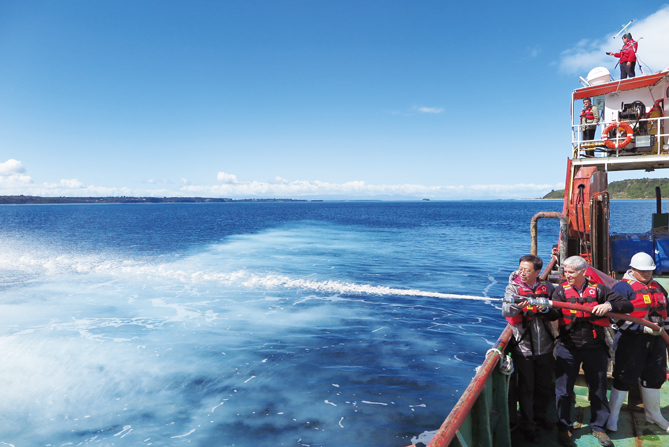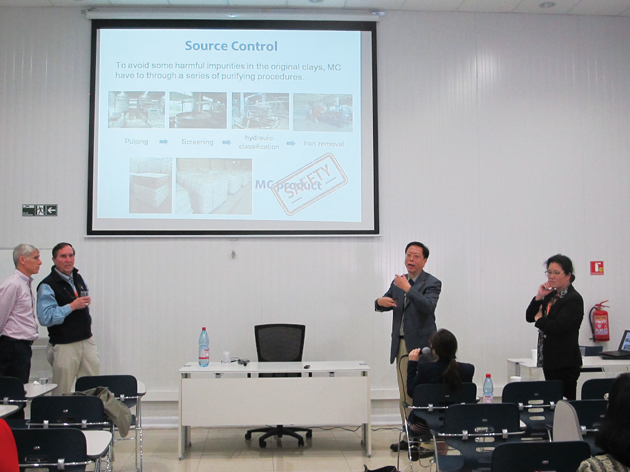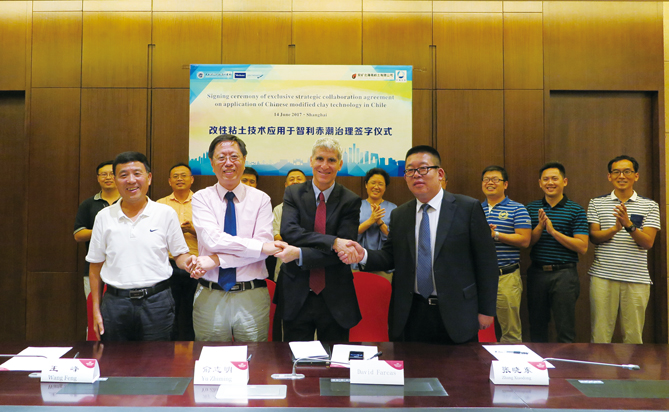By ZHANG Xudong (Xinhua News Agency)
Thanks to 27 tons of “magic soil” developed by Chinese scientists for Chile’s aquaculture industry, salmon there will enjoy their “summer vacation” in the southern hemisphere without fear of harmful algal blooms (HABs) known as red tides.
Red tides caused economic losses of 100 million U.S. dollars to Chile’s aquaculture industry between the end of 2015 and early 2016.
As the mix of “magic soil” and seawater is sprayed onto red tides by apparatus aboard ships, the majority of algae are carried down to the seabed through flocculation and the further growth of residual algae is inhibited.

Field demonstration of modified clay technology along Chilean coast.
New Hope for Salmon in Chile
As a main source of salmon and trout in the world, Chile’s aquaculture industry provides incomes for thousands of families. However, the toxic red tide has become a serious threat to those fishermen and their livelihood.
After catastrophic economic losses in 2016, Chile sought solutions to red tides and became interested in the modified clays, a major component of the “magic soil,” used in China as a HAB mitigation strategy.
In October 2016 a Chilean delegation with members from government, the aquaculture business and research institutes visited the Institute of Oceanology of the Chinese Academy of Science (IOCAS), which owns the technology of modified clays.

A Chilean delegation visits IOCAS to investigate modified clay technology.
The delegation observed demonstrations of the technology by a research group led by Prof. YU Zhiming from IOCAS and visited a manufacturing site of modified clays and special spray equipment and also witnessed live dispersal demonstrations in Beihai and Fangchenggang, cities of in the Guangxi Autonomous Region of south China.
The delegation and their hosts agreed to bring the modified clays technology to Chile to counteract the emergency posed by the red tide in coastal aquaculture zones of Chile, according to the Memorandum of Understanding (MoU) they signed after the visit.

Prof. YU introduces modified clay technology to Chilean aquaculture clients.
IOCAS and Virbac-Centrovet, a large aquaculture enterprise in Chile, and a representative of Simon Chile in cooperation with IOCAS, reached an exclusive strategic collaboration agreement in June of 2017.
“As agreed, we developed special modified clays in full consideration of their application in Chile and tested their effect on salmon and shellfish many times. It turns out that the new modified clays do no harm to the cultured species,” said YU.

Signing ceremony.
After third-party testing by the well-known Woods Hole Oceanographic Institution in America, 27 tons of modified clays were shipped from China on December 24, 2017, and arrived in Valparaiso, Chile 38 days later.
YU and three other researchers visited Chile for seven days in March 2018, talking with authorities of maritime affairs, fisheries and aquaculture in five cities, holding seminars on application details of modified clays, and demonstrating their dispersal aboard ships.

The first batch of modified clays arrive in Chile.
The 27 tons of modified clays will be dispersed onto the red tide when it appears on a large scale in November 2018 for the purpose of protecting salmon and other cultured species.
The cooperation between IOCAS and Virbac-Centrovet will continue in the coming years, according to their agreement.
Secret of China’s Modified Clays
Spraying clay, a basic component of the soil, is one of the few mitigation methods so far for HABs, but low flocculation efficiency has always been the most significant drawback associated with natural unmodified clays, requiring an exorbitant amount of clays to achieve an effective efficiency.
Experiments by YU’s research team showed that the surface charges of HAB cells and natural clay particles were both electronegative and hence had repulsive interaction, which caused low flocculation. It is one of the fundamental laws of electricity that like charges repel.
YU’s research team also found that the effective interaction radius of clay particles contributed to an improvement in flocculation efficiencies.
Therefore, the research team managed to change the surface charges of clay particles from negative to positive to increase attractive interaction between clay particles and HAB cells, enhancing flocculation efficiency through the insertion and absorption of modifiers such as poly-aluminum compounds (PAC) and aluminum sulfate.
The insertion and absorption are a series of physical and chemical processes.
“The modifiers can be both organic and inorganic matter as long as they can change the surface charges of clay particles from negative to positive and have appropriate molecular chain length, which increases charge neutralization between clay particles and HAB cells,” YU said.
Production of modified clays has been industrialized in China. It involves slurry water screens, magnetic separation and purification, surface modification, pressure filtration and dehydration, and establishment of ultrafine grinding, which guarantee the quality and stability of modified clay products.
Wiping Out HABs
The modified clays carry the majority of HABs to the sea bottom as the flocculation efficiency is increased several hundredfold and the dosing requirement is decreased sharply from 110~400 to 4~10 t/km2.
Based on field experiences, 70% to 80% of HABs can be removed by modified clays. Even so, 20% to 30% of initial algae could still be considered to be a blooming level.
However practice has shown that growth of residual algae was rarely observed after modified clay treatment.
Laboratory investigations revealed that contact between modified clays and HABs can generate large amount of reactive oxygen species (ROS), which are widely used in sterilization and curbing HABs’ growth and proliferation.

IOCAS experts give technical advice on how to apply modified clays in field to Chilean staff.
As noted, the modified clay carries HABs down to the seabed, which prevents the residual organisms from becoming “seeds” of HABs next year. Long term field observation showed no evidence of a second bloom from the sediments after a modified clay treatment.
This suggests that it is difficult for HAB organisms to escape from the flocs, and even if they have escaped their growth and survival environment have been severely compromised by the modified clays.
In the field the clay dispersal modes involve powder and suspension. Clay powder is directly dispersed onto HABs from planes, while the second mode requires the preparation of a suspension, which is then sprayed on the bloom by ships.
Although the efficiency of powder is much greater than the suspension, powder in the air affects the surrounding environment and therefore requires a specific apparatus for proper control. Because of this, suspension spraying is the most popular method.
Would Modified Clays Kill Other Flora and Fauna?
Since HABs often occur in aquaculture regions, the effects of modified clays on the surrounding flora and fauna are also a concern, especially their influence on shellfish and other filter-feeding organisms.
Studies showed that the modified clay didn’t pose any acute or chronic toxicity concern, as a very high concentration (far more than 1000 g/m3) of ball clay is needed before the level becomes toxic to milkfish, sea bass and rabbit fish.
“The effective dosage is only at 4~10 g/m2, so the modified clay to mitigate HABs has no negative influences on natural organisms,” YU said.
Furthermore, both laboratory and field results have shown that appropriate dosages of modified clays can introduce marked improvement in water quality while mitigating HABs.
Experiments showed that clays have a high absorption capacity for phosphate (30%) and that surface modification of clays can increase their absorption capacity for DIP (dissolved inorganic phosphorus) by 25% to 50%. In addition, modified clays can also remove particulate nutrients by flocculation to make water quality better.
Even with these benefits, could the algae settled by modified clays cause a secondary eutrophication as a result of nutrients released from the high biomass on the sea bottom?
“The answer is no,” YU said. “The algal organic matters combine with the clay particles to form a sandwich-matrix, in which organic phosphorus and other nutrients are effectively sealed and blocked.”
Application of Modified Clays in China
After first being applied in Xuanwu Lake in Nanjing in 2005, the modified clays technology has been successfully applied to mitigate HABs in many significant occurrences and more than 20 regions along China’s coastlines.
In August 2008, a massive HAB with an impacted area of 86 km2 occurred near the Olympic Sailing Center of Qingdao, threatening the sailing events of the Beijing Olympic Games.
About 360 tons of modified clays were continuously dispersed into the bloom water within 40 hours, and the green algae decreased by 1~2 orders of magnitude. Water quality was restored the day after treatment, and the potential threat to the sailing events was successfully eliminated.
In August 2016, a red tide occurred along the Qinghuangdao coast of China’s Hebei Province, which impacted several hundred square kilometers and posed a serious threat to adjacent aquaculture.
Approximately 100 tons of modified clays were sprayed to form an isolation belt to block the bloom from the aquaculture areas, and the density of dominant species declined by 96.8%. Water quality also improved as the Chemical Oxygen Demand (COD, an index of water pollution) decreased from 2.32 mg/L to 1.08 mg/L in two days.
It’s well known that HABs are capable of destroying ecosystems, putting aquaculture at risk, and even threating human health. It is not so well known, however, that HABs can threaten the safety of a nuclear station.
When the water cooling system of Fangchenggang nuclear power plant in Guangxi was blocked by one kind of algae named P.golobosa, the modified clay was selected by the national nuclear safety administration of China as the sole method for HAB treatment in the cooling water intake areas of the power plant.
During the P.golobosa bloom from December 2015 to February 2016, 210 tons of modified clays were sprayed, and the algal colonies were removed. The power plant’s safety was secured.
The modified clay technology was also applied to block HABs from the nearby waters of the BRICS Xiamen Summit’s venue in September 2017 and the Shanghai Cooperation Organization (SCO) Qingdao Summit’s conference center in June 2018.
Since 2014 the technology has been included as a standard method in the “Technical Guidelines for Treatment with Red Tide Disaster” in China. Currently, it is the only large-scale field application method for HAB mitigation in the nation.

